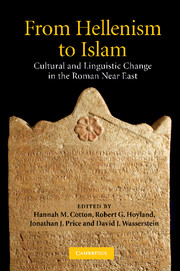Book contents
- Frontmatter
- Contents
- List of figures
- List of tables
- List of contributors
- Preface
- List of abbreviations
- Introduction: documentary evidence, social realities and the history of language
- Part I THE LANGUAGE OF POWER: LATIN IN THE ROMAN NEAR EAST
- Part II SOCIAL AND LEGAL INSTITUTIONS AS REFLECTED IN THE DOCUMENTARY EVIDENCE
- 3 Euergetism in Josephus and the epigraphic culture of first-century Jerusalem
- 4 Legal and social status of threptoi and related categories in narrative and documentary sources
- 5 Ritual performances of divine justice: the epigraphy of confession, atonement, and exaltation in Roman Asia Minor
- 6 Continuity of Nabataean law in the Petra papyri: a methodological exercise
- Part III THE EPIGRAPHIC LANGUAGE OF RELIGION
- Part IV LINGUISTIC METAMORPHOSES AND CONTINUITY OF CULTURES
- Part V GREEK INTO ARABIC
- Index
3 - Euergetism in Josephus and the epigraphic culture of first-century Jerusalem
Published online by Cambridge University Press: 01 March 2010
- Frontmatter
- Contents
- List of figures
- List of tables
- List of contributors
- Preface
- List of abbreviations
- Introduction: documentary evidence, social realities and the history of language
- Part I THE LANGUAGE OF POWER: LATIN IN THE ROMAN NEAR EAST
- Part II SOCIAL AND LEGAL INSTITUTIONS AS REFLECTED IN THE DOCUMENTARY EVIDENCE
- 3 Euergetism in Josephus and the epigraphic culture of first-century Jerusalem
- 4 Legal and social status of threptoi and related categories in narrative and documentary sources
- 5 Ritual performances of divine justice: the epigraphy of confession, atonement, and exaltation in Roman Asia Minor
- 6 Continuity of Nabataean law in the Petra papyri: a methodological exercise
- Part III THE EPIGRAPHIC LANGUAGE OF RELIGION
- Part IV LINGUISTIC METAMORPHOSES AND CONTINUITY OF CULTURES
- Part V GREEK INTO ARABIC
- Index
Summary
The epigraphical remains of Jerusalem from the period between the reign of Herod and the Destruction (37 BCE–70 CE) are unlike those of most other cities of comparable size (however precisely we calculate this) and importance in the eastern Roman Empire. In brief, the overwhelming majority of public, or quasi-public, writings consists of graffiti scratched on limestone ossuaries. These inscriptions, of which there are several hundred, normally record only the name of the deceased, usually either in Aramaic letters or in Greek (a handful are in Palmyrene), without so much as a hic iacet, though there are exceptions. Inscriptions of similar type have been found in burial caves and monumental nefashot, or mausolea, scattered around the outskirts of the city. Even here, though, writing is much less common than in the earlier burial caves of Marisa/Tell Sandahanna, or the later ones of Bet Shearim. As examples of what is there, there is an enigmatic, and very roughly carved, graffito from the ‘Tomb of the Kings’, and a longer graffito, interestingly in Hebrew, listing the names of the members of the priestly clan of Hezir buried in their famous mausoleum in the Kidron Valley (CIJ 1388, 1394).
Several non-funerary inscriptions have turned up, too, for example in the Jewish Quarter excavations – but these are similar in character to the funerary inscriptions, very brief, often graffiti, often apparently simply marking possession of an item.
- Type
- Chapter
- Information
- From Hellenism to IslamCultural and Linguistic Change in the Roman Near East, pp. 75 - 92Publisher: Cambridge University PressPrint publication year: 2009
- 3
- Cited by



